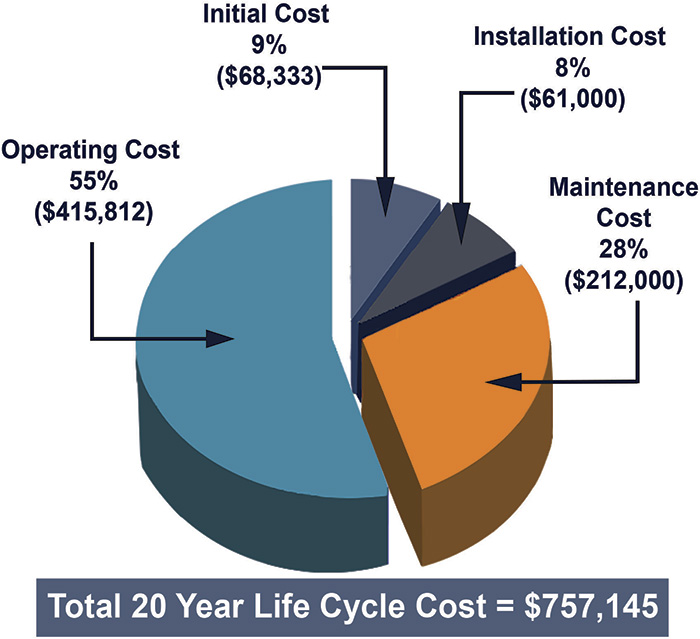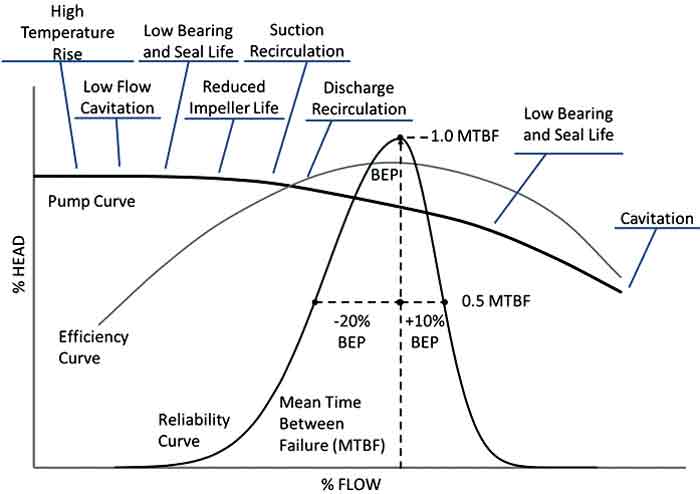Wastewater treatment facilities, chemical and power-generation plants, electric and gas companies, municipalities, and commercial buildings all have a common prime mover—centrifugal pumps. Collectively, these pumping systems represent an enormous amount of electrical energy usage. Pump systems, on average, represent the highest energy usage of any type of rotating equipment employed in industrial and commercial facilities. For example, pumping systems account for 20 to 30 percent of electrical energy consumption in wastewater plants and up to 46 percent in municipal water systems. By comparison, chemical and allied product plants typically use enough electrical power in pump systems to run a small city. Pump system designs are normally in the range of 65 to 85 percent at their best efficiency point (BEP). Because of oversizing and sometimes undersizing, pump systems typically operate well below their BEP. The excess energy usage is transmuted into vibration, heat and noise, all of which increase maintenance and energy costs. When not optimized for best efficiency, pump systems drain maintenance budgets by decreasing the mean time between repairs. Pump systems represent one of the best ways to reduce overall plant operating costs.
The Underlying Cause of Pump Inefficiency
 Figure 1. Life-cycle cost of a standard 75-hp pumping system over 20 years of operation (Graphics courtesy of Hydraulic Institute)
Figure 1. Life-cycle cost of a standard 75-hp pumping system over 20 years of operation (Graphics courtesy of Hydraulic Institute) Figure 2. The impact on pump reliability when operating outside of its acceptable range. Note that most of the issues occur when the pump is operating to the left of design, which is where pumps typically operate due to oversizing.
Figure 2. The impact on pump reliability when operating outside of its acceptable range. Note that most of the issues occur when the pump is operating to the left of design, which is where pumps typically operate due to oversizing. Effects of Pump Inefficiency
For maximum efficiency, pumps should operate at or near their mechanical BEP. Optimally, pumps should not run at flow more than 10 to 15 percent outside of the BEP. When operating at excess capacity or greater than BEP, pumps may surge and vibrate, creating potential bearing and shaft seal problems while requiring excessive power. Cavitation may also occur, causing damage to pump components. When pumps operate at reduced capacity, or lower than BEP, fixed-vane angles may cause eddy currents within the impeller, inside the casing and between the wear rings. The radial thrust on the rotor will increase, causing higher shaft stresses, increased shaft deflection, and potential bearing and mechanical seal problems. Radial vibration and axial shaft movement will also increase. Figure 2 shows the effects of operating away from the BEP on the pump.The Need for Pump Systems Optimization
Systems optimization is the process of evaluating pumping systems to identify opportunities for improvements that will reduce energy consumption and improve reliability. Improving a single component—installing a more efficient motor, for example—will do little to improve overall system efficiency. Engineers who wish to implement systems optimization must evaluate how all pump components work together and determine how to make certain system changes to improve net efficiency. Greater pump system efficiency achieved through systems optimization will improve reliability and lower operating costs by reducing wear and tear. This will decrease downtime and costs associated with lost production, maintenance and repairs, while extending equipment life. Costs associated with downtime routinely exceed energy and reliability costs combined.Approaches to Systems Optimization
As with any engineering project, the pump systems optimization process begins with organizing an assessment team. The individuals chosen should be knowledgeable in one or more critical areas. The team will also work cross-functionally with the team leader and other members to meet the study’s overarching goals. The following steps are vital to a successful pump systems optimization program.1. Prescreening
Initially, pumps are prescreened to identify those with the greatest savings potential. Pumping systems should be screened for any of the following symptoms:- highly throttled flow-control valves
- existence of bypass line (recirculation) flow regulation
- batch-type processes involving one or more pumps running continuously
- frequent on/off pump cycling
- cavitation noise either at the pump or in the system
- parallel pump system with the same number of pumps always working
- a pump system that has undergone a change in function without modification
- a pump system with no means of measuring flow, pressure or power
2. Assessment
Next, pump systems selected for assessment must be thoroughly evaluated. Depending on the requirements of the plant or facility, the selection of the correct pump system assessment level is important to meet the project’s goals.- Level 1 pump system assessment is a qualitative review that determines potential energy savings and reliability improvements to identify pumps worthy of further attention.
- Level 2 is a quantitative review that determines energy consumption and reliability improvements based on measurement made during steady-state operating conditions using a single set of measurements.
- Level 3 is a quantitative review measuring system demands by tracking and monitoring the system over longer time periods to obtain various operating conditions.
3. Data Collection
The next step in the systems optimization process involves data collection. Data are collected on energy costs and the pump systems using appropriate data-acquisition systems. For example, collected data can be used to compare the measured rates of flow and head to the required rates. An analysis may reveal an imbalance between measured and required conditions, which is evidence of an inefficient system. Comparing existing operating conditions to design conditions can also show an improperly sized pump. An original pump performance curve can be useful for constructing a curve for the operating points of the existing system. Comparing a single test point to the original curve can help determine if the first step to systems optimization will be the overhaul of a worn pump or if the system must be further investigated. The curve will also help determine if the rotodynamic pump is operating at its BEP. Those operating outside the BEP range will be inefficient and consume more energy. Other components of the existing system also must be assessed, including valves, bypass lines, piping configurations and suction piping that may provide optimization opportunities.4. Life-Cycle Costing
Because the odds of receiving approval for optimization projects are significantly higher when the potential projects can be proven to improve plant profitability and reduce operating costs, an LCC analysis can justify system optimization by indicating a lower total cost of ownership. In an LCC analysis, the following elements are reviewed:- initial purchase
- installation and commissioning
- electrical or other energy costs
- operation costs
- maintenance and repair costs
- downtime costs
- environmental costs
- decommissioning/disposal costs LCC analysis requires an evaluation of alternative systems. Because lifetime energy and maintenance costs dominate life-cycle costs, end users must know the current cost of energy to estimate the annual price escalation for energy and maintenance costs.
- increased productivity
- reduced production costs
- improved product quality
- improved capacity utilization
- improved reliability
- improved worker safety
5. Benefits Documentation
Advantages of pump systems optimization not readily quantified through an LCC analysis include:Training Opportunities
The Hydraulic Institute recently introduced a Pump Systems Assessment (PSA) Certificate Program that provides instruction on how to gauge the knowledge and capabilities of individuals required to conduct pump systems assessments and implement process changes at facilities.
As the pool of nationally certified PSA professionals grows, industry will become increasingly confident in the implementation of pump systems optimization initiatives. Over time, this educational effort will help increase the average pump system efficiency above today’s average of 40 percent. Also, energy consumption in pump systems will begin to decrease as recommended mechanical and control modifications are implemented.

